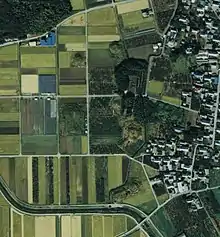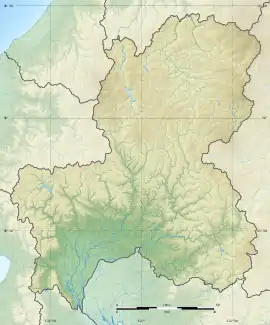No Kofun Cluster
No Kofun Group (野古墳群, No Kofun-gun) is cluster of small kofun burial mounds located in what is now part of the town of Ōno, Gifu in the Chubu region of Japan. The site was designated a National Historic Site of Japan in 1957.[1]
野古墳群 | |
 No Kofun Group | |
 No Kofun  No Kofun Cluster (Japan) | |
| Location | Ōno, Gifu, Japan |
|---|---|
| Region | Chubu region |
| Coordinates | 35°28′48″N 136°37′31″E |
| Type | kofun |
| History | |
| Founded | late 5th to early 6th century AD |
| Periods | Kofun |
| Site notes | |
| Ownership | National Historic Site |
| Public access | Yes |
Overview
The kofun group is located in the northwestern corner of the Nōbi Plain in northwestern Gifu Prefecture, surrounded by rice fields and orchards. In a roughly one square kilometer area, there were once over 200 tumuli, of which 14 theoretically received protection in 1957 as a National Historic Site. At present, only nine remain; with the others being destroyed for expansion of farm land. Of these remaining nine, eight have been excavated, and from the grave goods recovered (haniwa, copper mirrors, horse fittings iron and wooden implements), were determined to date to the middle of the 5th century to the early part of the 6th century.
| # | Name | type | Dimensions | Comments |
|---|---|---|---|---|
| 1 | Motare Kofun (モタレ古墳) | keyhole-shaped | 54m (L) x 36m (D) x 6m (H) | Originally thought to be a cave-tomb, excavations in 1989 confirmed that it was a moated keyhole-shaped tomb. Fragments of haniwa, Sue ware and a wooden plough were recovered. |
| 2 | Fudozuka Kofun (不動塚古墳) | keyhole-shaped | 64m (L) x 44m (D) x 7m (H) | Excavations in 1989 found fragments of haniwa; most of the mound has been lost |
| 3 | Minamiyashiki-nishi Kofun (南屋敷西古墳) | keyhole-shaped | 76m (L) x 44m (D) x 5.4m (H) | Excavations in 1982 found that it was double-moated; fragments of cylindrical haniwa were found |
| 4 | Noborikoshi Kofun (墳登越古墳) | keyhole-shaped | 83m (L) x 52m (D) x 7.3m (H) | The largest in the group. It was double-moated; fragments of cylindrical haniwa were found |
| 5 | Jōtsuka Kofun (城塚古墳) | keyhole-shaped | 75m (L) x 39m (D) x 6.2m (H) | In excavations, a Chinese-made bronze mirror, horse harness and a large sword were found in the burial chamber. |
| 6 | Inui Yashiki Kofun (乾屋敷古墳) | keyhole-shaped | 79m (L) x 49m (D) x 6.3m (H) | Thought to be the oldest in the group. Half-destroyed by residential housing; some haniwa have been recovered. |
| 7 | -unnamed- | scallop-shaped | 29m (L) x 22.6m (D) x 4.2m (H) | Thought to be a circular tumuli, its design was confirmed in 1923. |
| 8 | -unnamed- | square-shaped | 15.8 (L) x 15.8m (D) x 3.0m (H) | Excavated in 1994 |
| 9 | -unnamed- | keyhole-shaped | 30.5 (L) x 23m (D) x 6m (H) | Excavated in 1994, haniwa, Sue pottery were uncovered. |
References
- "下船塚古墳" [No Kofun Group] (in Japanese). Agency for Cultural Affairs.
External links
- Ono town home page (in Japanese)
- Gifu Prefectural home page (in Japanese)